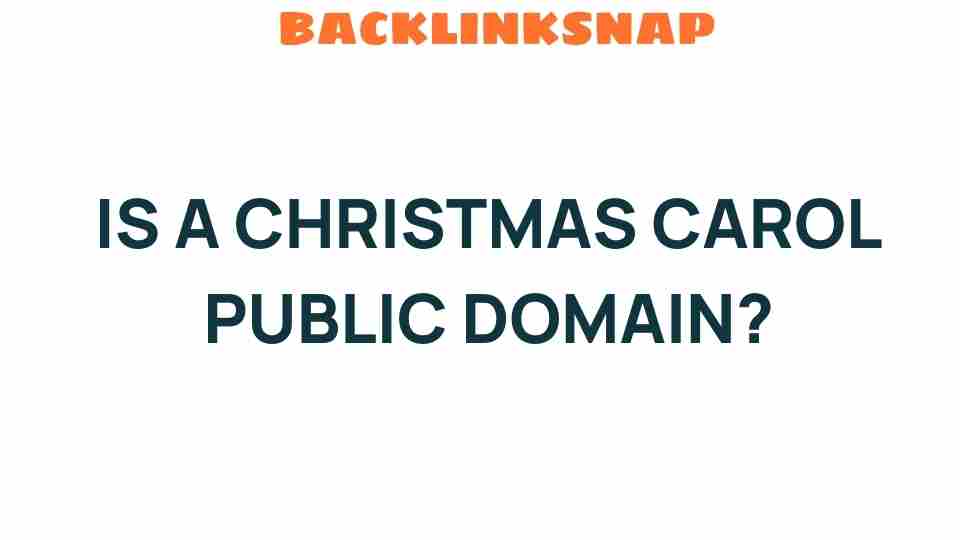Is A Christmas Carol Public Domain? Unraveling the Legal Mysteries
Every holiday season, as Christmas lights twinkle and the scent of gingerbread fills the air, Charles Dickens’ timeless tale, A Christmas Carol, finds its way into our homes. But have you ever pondered the legal intricacies surrounding this beloved narrative? Is A Christmas Carol actually in the public domain? In this article, we’ll dive deep into the realms of copyright, literary rights, and the status of this holiday classic.
Understanding Public Domain and Copyright
To grasp the status of A Christmas Carol, it’s essential to understand what public domain means. Works in the public domain are free for anyone to use without permission or payment. This typically includes works whose copyright has expired or never existed in the first place.
Copyright, on the other hand, is a legal framework that grants creators exclusive rights to their works for a specified period. In the U.S., for works published after January 1, 1978, copyright lasts for the life of the author plus 70 years. For works published before this date, the rules can vary significantly, making it crucial to pinpoint when a work was first published and the subsequent copyright changes over the years.
Charles Dickens and A Christmas Carol
A Christmas Carol was first published in 1843. Dickens wrote this novella as a response to the social injustices of his time, aiming to inspire compassion and generosity. The story of Ebenezer Scrooge’s transformation has since become synonymous with Christmas, influencing countless adaptations in literature, film, and theater.
Given that Dickens passed away in 1870, most of his works, including A Christmas Carol, have long since entered the public domain. In fact, the copyright on A Christmas Carol expired in the United States in 1891, making it freely available for use and adaptation. This means that anyone can create their own version, reinterpret the story, or even create merchandise inspired by it without seeking permission.
The Importance of Literary Rights
While A Christmas Carol itself is in the public domain, it’s worth noting that adaptations and modern retellings may still be protected by copyright. For example, a contemporary retelling set in a different context, with original characters or plotlines, could hold its own copyright.
As a result, it’s crucial for creators to understand the difference between the original work and any derivative works. The intellectual property associated with adaptations can be complex, and navigating these waters requires awareness of the legal landscape.
Why Does It Matter? Cultural Heritage and Accessibility
The fact that A Christmas Carol is in the public domain has significant implications for cultural heritage. It allows for wide accessibility and encourages creativity. Authors, filmmakers, and artists can draw inspiration from this classic without worrying about licensing fees or legal restrictions. This accessibility fosters a richer cultural dialogue around the themes presented in Dickens’ work.
Moreover, public domain works can be disseminated freely in various formats—be it through print, digital media, or theatrical productions. This ensures that the story continues to resonate with new generations, keeping the spirit of Dickens’ message alive.
Modern Adaptations of A Christmas Carol
Since its publication, A Christmas Carol has been adapted into numerous formats, including films, stage plays, and even musicals. Some notable adaptations include:
- Scrooged (1988) – A modern comedic take starring Bill Murray.
- The Muppet Christmas Carol (1992) – A family-friendly version featuring beloved Muppet characters.
- A Christmas Carol: The Musical – A theatrical adaptation that brings the story to life through song and dance.
These adaptations highlight how public domain status allows for creative reinterpretation while maintaining the core message of the original work. Each version brings forth new perspectives, making the story relevant to contemporary audiences.
Frequently Asked Questions
1. Is A Christmas Carol in the public domain?
Yes, A Christmas Carol is in the public domain, as it was published in 1843 and the copyright has since expired.
2. Can I adapt A Christmas Carol for my own project?
Absolutely! Since it is in the public domain, you can adapt, modify, or reinterpret the story without seeking permission.
3. Are there any adaptations of A Christmas Carol that are still under copyright?
Yes, while the original novella is public domain, specific adaptations—like films or modern retellings—may still hold copyright protection.
4. How does public domain status benefit cultural heritage?
Public domain status allows for greater accessibility to classic works, encouraging creativity and the sharing of ideas across generations.
5. Can I sell my adaptation of A Christmas Carol?
Yes, since the original work is in the public domain, you are free to sell your adaptation, provided it contains your own original elements.
6. Where can I find the original text of A Christmas Carol?
You can find the original text available for free online at various sites, including Project Gutenberg.
Conclusion
In conclusion, A Christmas Carol stands as a hallmark of literary and cultural heritage, firmly planted in the public domain. This status not only allows for limitless creativity and adaptation but also ensures that Dickens’ powerful messages of compassion and transformation continue to resonate with audiences today. As we celebrate the season of giving, let us cherish the legacy of A Christmas Carol and embrace the joy of sharing its story with one another, knowing that this classic belongs to us all.
This article is in the category Digital Marketing and created by BacklinkSnap Team




